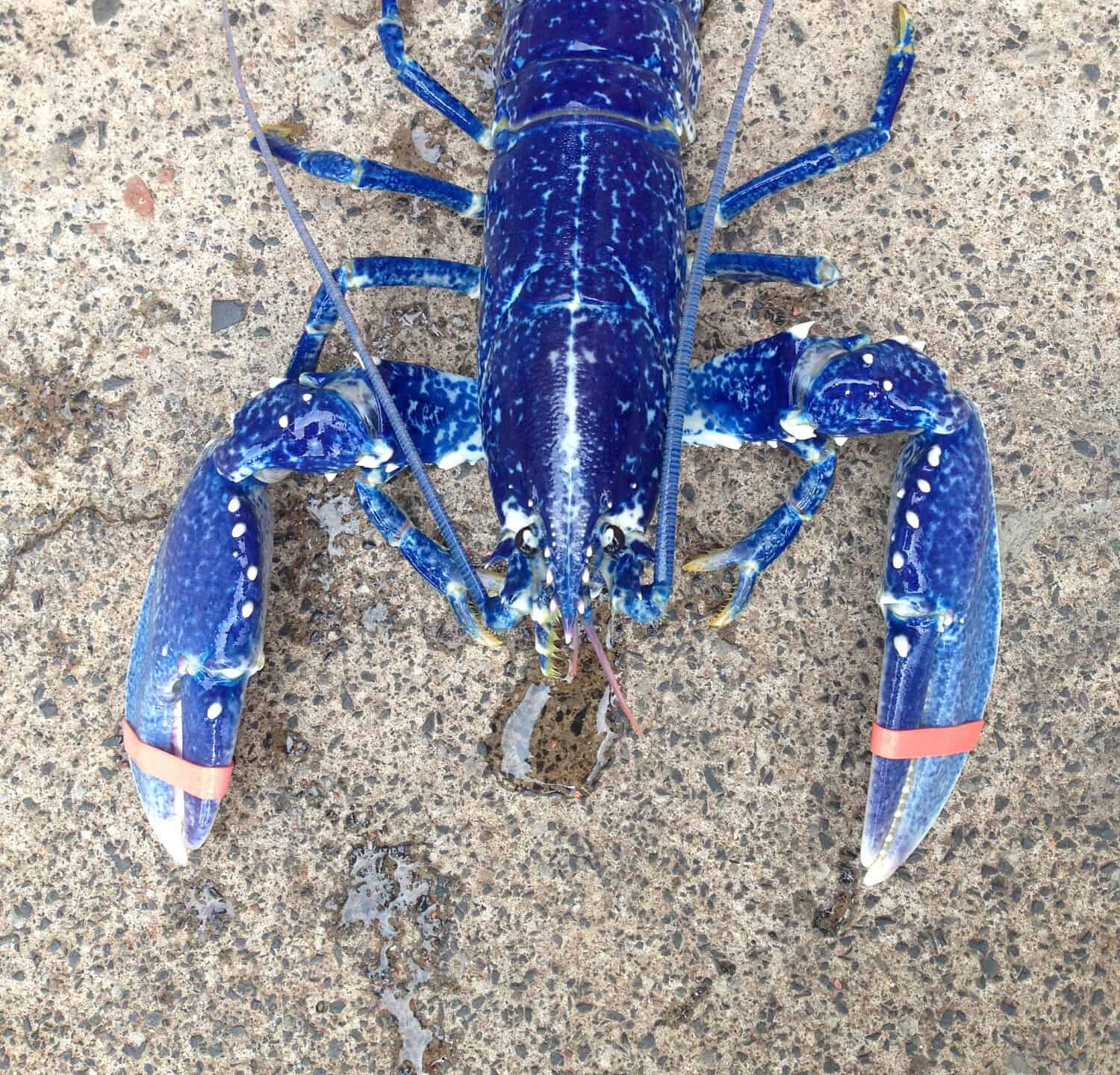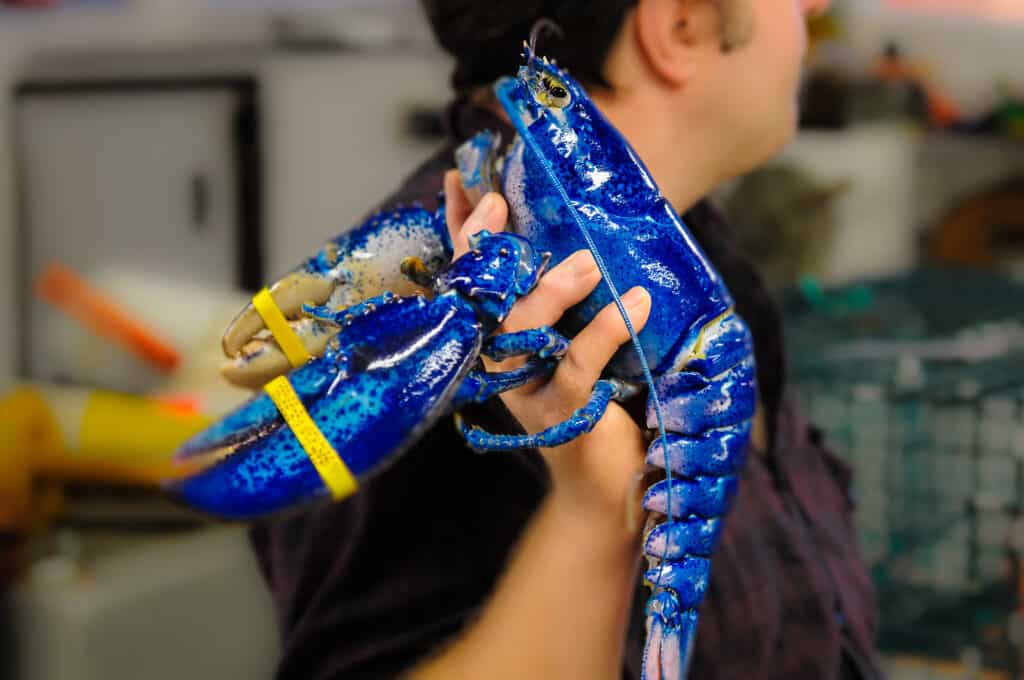Lobsters have nearly always sparked the imagination of scientists and the taste buds of seafood enthusiasts. They have a distinctive appearance and smooth, delicious taste. Most of these crustaceans have a brown coloring, which helps them hide from predators. But nature occasionally surprises us. That is certainly the case with some remarkable and rare lobster colors. Below we dive into the top 9 rarest lobster colors. Keep reading to find out more (and perhaps discover a new favorite).

Blue lobsters truly stand out from the crowd compared to their brown-hued relatives.
©Aromira14/Shutterstock.com
1. Albino Lobster

Rarely seen, this albino lobster lives deep in the ocean.
The albino lobster is the rarest and most sought-after color variation. These incredibly rare lobsters lack the pigmentation that gives lobsters their typical coloration. Thanks to a genetic condition called leucism, albino lobsters don’t even turn red when cooked. The chances of catching one of these remarkable animals are 1 in 100 million.
Albino lobsters are so rare that aquariums and high-end restaurants often compete for the handful caught. When restaurants get their hands on these stunning lobsters, they can charge top dollar. Usually, however, they get donated to aquariums or released back into the ocean.
2. Cotton Candy Lobster
Most experts believe cotton candy lobsters to be 1 in 100 million, tying the albino lobster for the rarest coloring. But it is unclear how many of the uniquely colored animals live in the wild. They have bright, light blue shells covered in tiny speckles.
Scientists don’t know exactly why some lobsters sport this bright, sparkly color. But they suspect it is due to either a genetic issue or, possibly, their diet. In 2021, a lobsterman in Maine caught a cotton candy lobster. It subsequently moved into the Seacoast Science Center for safety.
3. Split-colored Lobster
The split-colored lobster, also known as a “bicolor lobster,” has two distinct colors on its shell. Often, the colors get divided right down the lobster’s center. Split-colored lobsters appear in roughly 1 in every 50 million. These lobsters also possess both female and male characteristics. Scientists believe this phenomenon occurs due to a cellular split immediately following fertilization.
One of these unique creatures found its way to the Seacoast Science Center in Maine in 2021. This rare crustacean gives visitors a visual treat and helps scientists better understand how some of these rare colored lobsters come to be.
4. Yellow Lobster
Yellow lobsters, also known as “golden lobsters,” boast a vibrant hue reminiscent of the sun. This stunning color variation is due to a genetic mutation affecting the pigmentation of their shell. The odds of encountering a yellow lobster are roughly 1 in 30 million. Yellow lobsters have gotten spotted primarily along the East Coast.
Collectors and restaurants seek yellow lobsters due to their rarity and eye-catching appearance.
5. Calico Lobster
It turns out that cats are not the only creature sporting calico colors. Calico lobsters, sometimes called cinnamon lobsters, also occasionally boast this unique color variation. It features a mixture of orange, black, and yellow, creating a visually striking appearance. The chances of seeing or catching a calico lobster are approximately 1 in 30 million. Their speckled look comes from a genetic mutation affecting the pigment in specific cells.
One calico lobster even became famous. ‘Freckles.’ was found (and named) by Red Lobster employees. The restaurant worked with the Virginia Living Museum to relocate the unique creature. ‘Freckles’ was a beloved addition to the museum until it died in 2022.
6. Orange Lobster
Fiery orange lobsters are incredibly vibrant. Although less rare than other colors on this list, spotting an orange lobster remains uncommon, with odds estimated at around 1 in 30 million. The reason behind this crustacean’s unusual pigment remains a mystery. Scientists suspect it is due to diet or genetics, but they aren’t sure which.
Thankfully, the University of New England’s Marine Science Center has a new orange lobster to study. It arrived at the center in 2023. Scientists and students now have a chance to learn about the remarkable creature.
7. Red Lobster
No, this does not refer to the popular seafood restaurant. Instead, the eighth-rarest lobster color belongs to a real, live red lobster. We are accustomed to seeing red lobsters once they have been cooked. But there are even some naturally red lobsters alive in the wild. These stunning creatures appear about every 1 in 10 million. They most likely have an excess of one specific pigment resulting in their bright coloration.
8. Blue Lobster
The beautiful blue hue on some lobsters is mesmerizing and exceedingly rare. Estimates of encountering a blue lobster sit at around 1 in 2 million. They primarily live in the waters of the North Atlantic Ocean. Some notable areas include the coast of New England and Canada’s Maritime provinces.
Their unusual color comes from a genetic anomaly causing an overproduction of a specific protein. The protein interacts with carotenoids, producing the striking blue coloration. And catching one of these beauties is often thought of as good fortune.

Beautiful blue lobsters are rare, but not as rare as some of the other colors.
©Marentze/Shutterstock.com
Summary of Top 8 Rarest Lobster Colors
| Color | Chances of Seeing One | |
|---|---|---|
| 1. | Albino | 1 in 100 million |
| 2. | Cotton Candy | 1 in 100 million |
| 3. | Split-Colored | 1 in 50 million |
| 4. | Yellow | 1 in 30 million |
| 5. | Calico | 1 in 30 million |
| 6. | Orange | 1 in 30 million |
| 7. | Red | 1 in 10 million |
| 8. | Blue | 1 in 2 million |
Thank you for reading! Have some feedback for us? Contact the AZ Animals editorial team.







